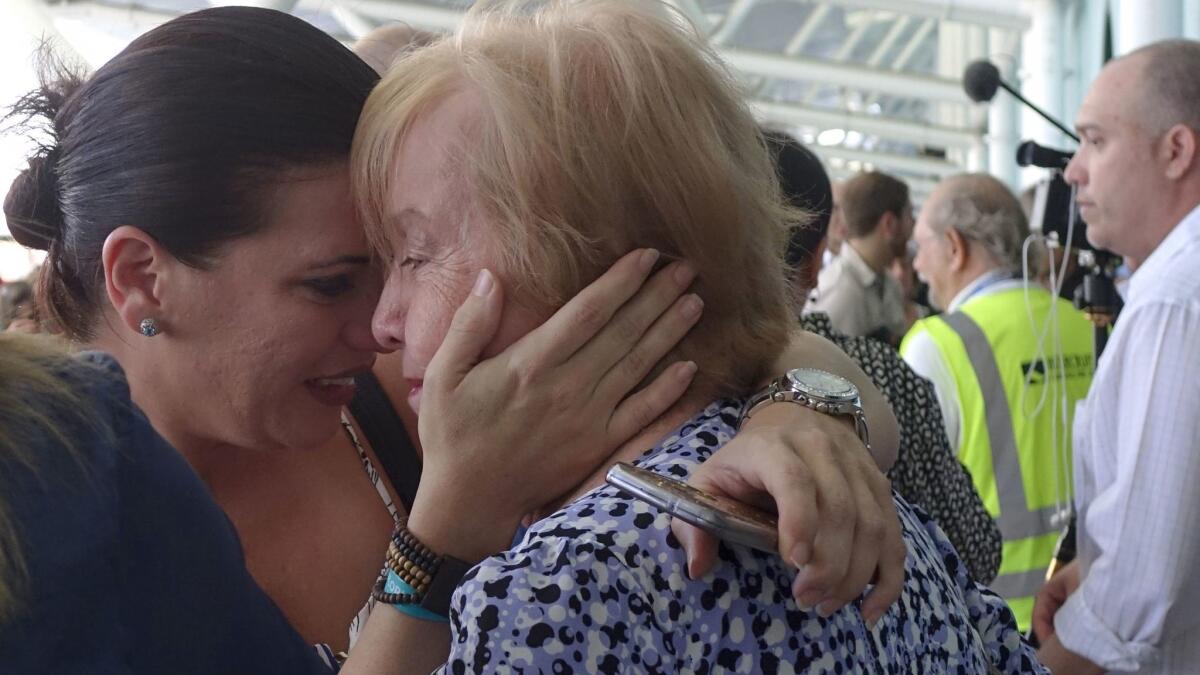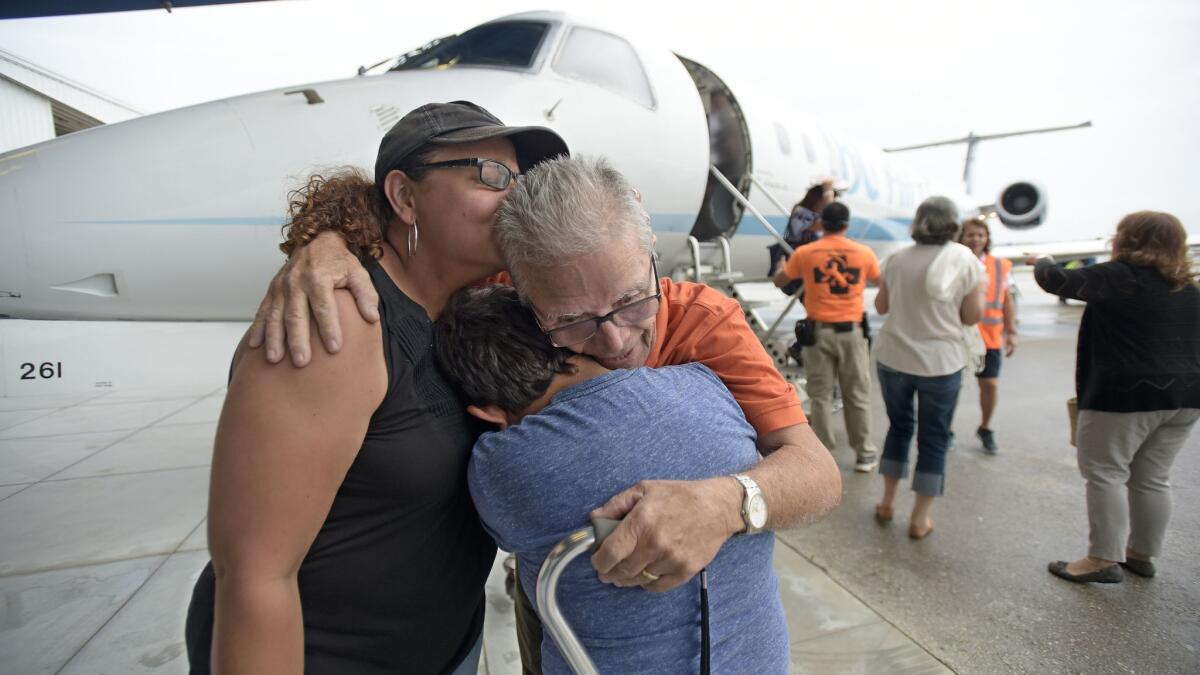Puerto Ricans fleeing their hurricane-ravaged island are pouring into the U.S. mainland
- Share via
Reporting from ORLANDO, Fla. — When Sinthia Colon’s sister-in-law called from Orlando offering plane tickets to flee Puerto Rico, she did not hesitate. Hurricane Maria had destroyed her small farm, wrecked the local power grid and spurred her town of San Lorenzo to impose a curfew to combat looting.
In a few hours, she was bound for Florida.
“It was, like, all of a sudden … I’m going,” Colon, 42, said shortly after arriving at a disaster relief center at Orlando International Airport with her daughter, son and mother-in-law. “I didn’t have time to make plans.”
Two weeks after the storm devastated Puerto Rico, tens of thousands of hurricane evacuees are packing scheduled flights and charter jets in what officials there and in states across the U.S. fear is the beginning of a mass exodus of historic proportions.
The mainland had already been absorbing record numbers of Puerto Ricans fleeing economic decline and a mounting debt crisis, with more than 700,000 migrating between 2006 and 2015. Some people also moved back over that time, but after decades of population growth, the island saw the total number of residents drop from about 3.8 million to 3.4 million — or more than 10%.
The majority of those who moved were of working age, compounding the economic damage.
Now that cycle is poised to accelerate in a migration that could have profound implications for the rebuilding of the island and for U.S. politics.
“This has no historical precedent for the United States,” said Jesse Keenan, a Harvard professor who specializes in climate adaptation and resilience.
“If just 10% of people leave, it’s going to have a huge impact, both in Puerto Rico and on the mainland,” he said. “If as many as 20% left, which wouldn’t surprise me, it would completely collapse the island’s economy and burden jurisdictions across the United States.”

As U.S. citizens, the evacuees have a legal right to move anywhere in the country. Many are bound for Florida, which is already home to more than a million Puerto Ricans, or nearly a fifth of the 5.4 million living in the 50 states.
Florida Gov. Rick Scott declared a state of emergency in all 67 Florida counties last week and opened three disaster relief centers at Orlando and Miami airports and the Port of Miami.
The Orlando metropolitan area — which already has a decidedly Puerto Rican flavor, with an abundance of restaurants serving mofongo, sofrito and pastelillos — is bracing for as many as 100,000 evacuees. Local officials and volunteers are already scrambling to help thousands of new arrivals find new homes, jobs and schools.
“If we don’t prepare, it is really going to hurt our local economy,” said Emily Bonilla, a Democrat of Puerto Rican descent who was elected last year to the Orange County Commission and is setting up a task force aimed at preventing the influx from driving up rents and depressing wages.
“We knew we were going to grow, and grow fast, but this is speeding the process up exponentially,” she said. “We are not prepared. We do not have the housing. We have to act fast.”
The size of the influx in Florida — and New York, Illinois and Pennsylvania, also home to large numbers of Puerto Ricans — is likely to depend on how fast the recovery is and how well the federal government responds to the disaster.
“Puerto Ricans are very resilient, but give them a few weeks without electricity and they’ll come running,” Bonilla said.
Jorge Duany, a professor of anthropology at Florida International University who left the island five years ago for his career, said that although a mass influx of Puerto Ricans is nearly guaranteed, at least one question is open: “Whether they will stay.”
After filling out paperwork at the relief center to register her 12-year-old daughter in school, apply for assistance from the Federal Emergency Management Agency and launch her job search, Colon said she had no idea how long she would remain in Orlando.
“I never thought of moving here, but here I am,” she said upon leaving the relief center with an emergency food box of canned tuna, pouches of beef tacos and granola bars. “I’ve got all the information I need to get a job. Maybe I will get a house? I’m a quick learner. I think I can do anything.”
After Hurricane Katrina in 2005, more than half of New Orleans’ 480,000 residents moved out. Yet over the years, nearly half of those came back. The city has gradually rebounded to 390,000.

“People seem to have strong ties to New Orleans, despite the fact it was not a thriving city,” said Tatyana Deryugina, an assistant professor of finance at the University of Illinois who studies the economic impact of disasters. “With Puerto Rico, I would expect many of those who leave will want to return. Whether they will depends a lot on how much is rebuilt.”
She said that reconstructing Puerto Rico will be far more complicated than the recovery from Katrina, which cost the federal government about $50 billion — about $100,000 per resident.
A failure in Puerto Rico could have deep political repercussions for Republicans. Puerto Ricans tend to vote Democrat, at least in recent years, and Florida is one of the nation’s tightest swing states.
President Trump won by about 113,000 votes in Florida. Of the 50 million ballots cast by Floridians in the seven presidential elections since 1992, a difference of 18,000 votes separate Republicans and Democrats, said Steve Schale, a Democratic political strategist in Florida who directed Obama’s Florida campaign in 2008.
“In a state where elections are decided by a point, 100,000 potential new voters that lean Democratic — that’s a lot,” he said.
That consideration has been lost on few as political leaders in Florida has pressed the federal government to do more to repair infrastructure, address health issues, provide housing and restore agriculture on the island.
“While we’ll welcome anyone to central Florida, we’re also conscious of the fact that a mass exodus for the island would hurt long-term prosperity efforts there,” said Rep. Darren Soto, a Democrat who is of Puerto Rican descent and whose congressional district includes Orlando. “We want people who want to stay on the island to be able to do so. We just need to get help to them.”
Frustrated by what they view as a slow response by the federal government, many Puerto Ricans in Orlando were focused on shipping supplies to the island and helping the new wave of evacuees.
So many residents dropped off bottles of water, canned food, diapers and medical supplies at a community ballroom space, Acacia’s El Centro Borinqueno, that organizers stopped taking donations last week until they receive new shipping containers.
While visiting the storm-ravaged island last week, Trump told assembled officials, “I hate to tell you, Puerto Rico, but you threw our budget a little out of whack!”
Yet it remains unclear how much his administration is willing to invest in Puerto Rico.
Keenan, the Harvard expert, said that determination comes down to a choice: “The government needs to decide whether it would rather have people move to the mainland or try to have a more distributive recovery there in Puerto Rico.”
Jarvie is a special correspondent.
ALSO
FCC lets Alphabet try to use balloons to restore cell service to Puerto Ricans
Can Puerto Rico’s governor convince Trump his island should be a state?
More to Read
Sign up for Essential California
The most important California stories and recommendations in your inbox every morning.
You may occasionally receive promotional content from the Los Angeles Times.










